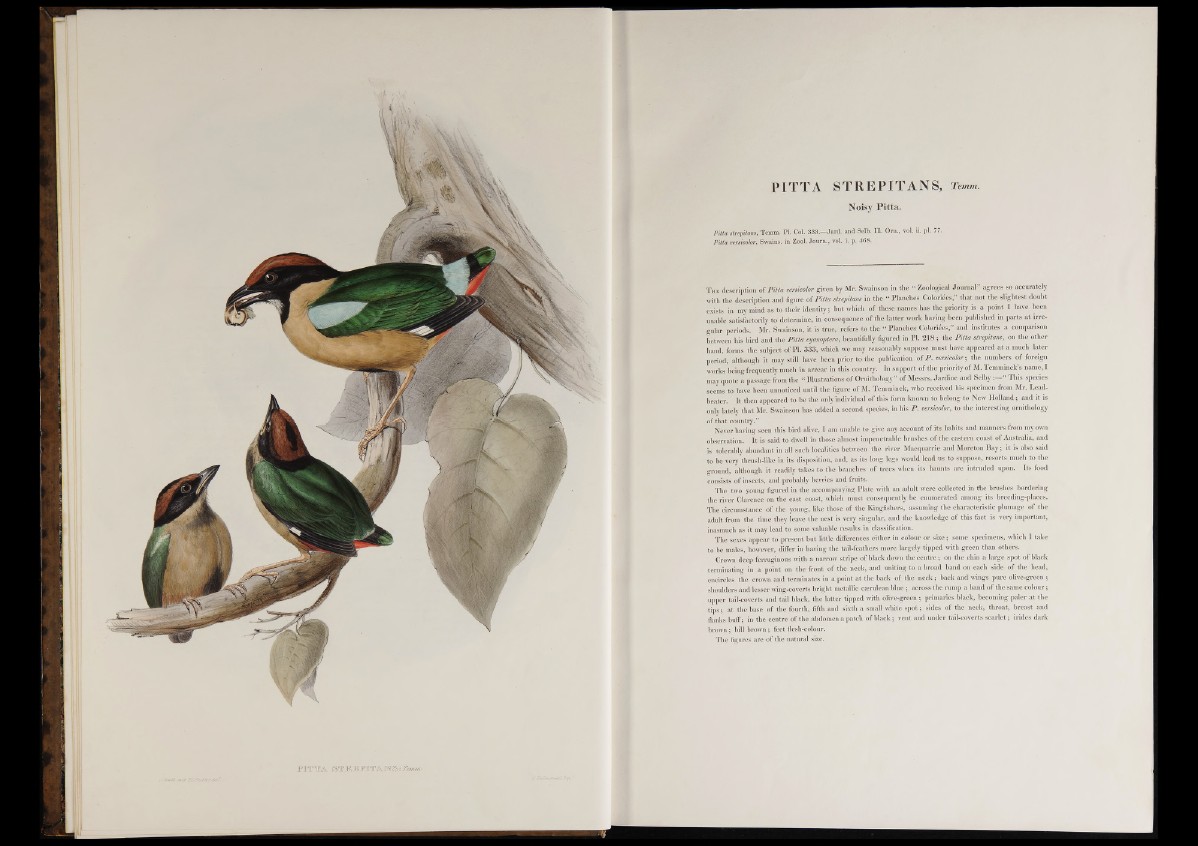
PITTA STREPITANS, Temm.
Noisy Pitta.
pitta strepitans, Temm. PI Col. S33—Jard. and Selb. 111. Om., vol: n. pi. 77.
Pitta versicolor, Swains, in Zool. Joura., vol. i. p. 468.
T h e description of Pitta versicolor given by Mr. Swainson in the “ Zoological Journal” agrees so accurately
with the description and figure of Pitta strepitans in the “ Planches Coloriées,” that not the slightest doubt
exists in my mind as to their identity; but which of these names has the priority is a point I have been
unable satisfactorily to determine, in consequence of the latter work haying been published in parts at irregular
periods. Mr. SwainsoD, it is true, refers to the ■■ Planches; Coloriées;” and institutes a comparison
between his bird and the Pitta cyanoptera, beautifully figured in PI. 218 ; the P itta strepitans, on the other
hand, forms the subject of PI. 333, which we may reasonably suppose must have appeared at a much later
period, although it may still have been prior to the publication of P . versicolor-, the numbers of foreign
works being frequently much in arrear in this country. In support of the priority of M. Temminck’s name, I
may quote a passage from the “ Illustrations of Ornithology” of Messrs. Jardine and Selby “ This species
seems to have been unnoticed until the figure of M. Temminck, who received his spteimen from Mr. Lead-
beater. It then appeared to be the only individual of this form known to belong to New Holland ; and it is
only lately that Mr. Swainson has added a second species, in his P . versicolor,, to the interesting ornithology
of that country.”
Never having seen this bird alive, I am unable to give any account of its habits and manners from my own
observation. It is said to dwell in those almost impenetrable brushes of the eastern coast of Australia, and
is tolerably abundant in all such localities between the river Macquarrie and Moreton Bay ; it is also said
to be very thrush-like in its disposition, and, as its long legs would lead us to suppose, resorts much to the
ground, although it readily takes to the branches of frees when its haunts are intruded upon. Its food
consists of insects, and probably berries and fruits.
The two young figured in the accompanying Plate with an adult were collected in the brushes bordering
the river Clarence on the east coast, which must consequently be enumerated among its hreeding-places.
The circumstance o f the young, like those of the Kingfishers, assuming the characteristic plumage of the
adult from the time they leave the nest is very singular, and the knowledge of this fact is very important,
inasmuch as it may lead to some valuable results in classification.
The sexes appear to present but little differences either in colour or size ; some specimens, which I take
to be males, however, differ in having the tail-feathers more largely tipped with green than others.
Crown deep ferruginous with a narrow stripe of black down the centre ; on the chin a large spot o f black
terminating in a point on the front of the neck, and uniting to abroad hand on each side o f the head,
encircles the crown and terminates in a point at the back- o f the neck ; back and wings pure olive-green ;
shoulders and lesser wing-coverts bright metallic cærulean blue ; across the rump a band of the same colour ;
upper tail-coverts and tail black, the latter tipped with olive-green ; primaries black, becoming paler at the
tips ; at the base of the fourth, fifth and sixth a small white spot ; sides of the neck, throat, breast and
flanks buff; in the centre of the abdomen a patch of black ; vént and under tail-coverts scarlet ; irides dark
brown ; bill brown ; feet flesh-colour.
The figures are of the natural size.